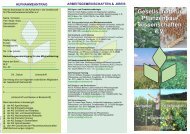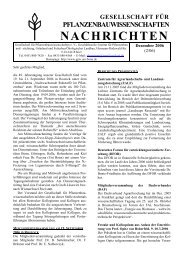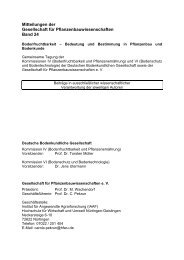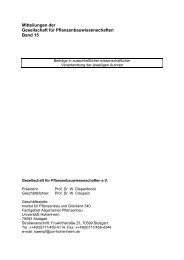Mitteilungen der Gesellschaft für Pflanzenbauwissenschaften Band 23
Mitteilungen der Gesellschaft für Pflanzenbauwissenschaften Band 23
Mitteilungen der Gesellschaft für Pflanzenbauwissenschaften Band 23
Erfolgreiche ePaper selbst erstellen
Machen Sie aus Ihren PDF Publikationen ein blätterbares Flipbook mit unserer einzigartigen Google optimierten e-Paper Software.
Mitt. Ges. Pflanzenbauwiss. <strong>23</strong>: 243 (2011)<br />
Sulfur nutrition of tomato (Solanum lycopersicum)<br />
in relation to its resistance against pathogens<br />
Katharina Bollig, Marc Zahn and Walter J. Horst<br />
Institute for Plant Nutrition, Faculty of Natural Science, Leibniz University Hannover. E-Mail:<br />
bollig@pflern.uni-hannover.de<br />
Introduction<br />
The soil borne fungus Verticillium dahliae (V. dahliae) causes vascular wilt disease<br />
and drastically limits crop yield worldwide (Fradin and Thomma, 2006). Since no<br />
effective fungicide preventing an infection is available current research focuses on<br />
the elucidation of possible resistance promoting mechanisms. One strategy seems to<br />
be the synthesis and deposition of the sulfur (S)-containing defense compound<br />
(SDC) elemental S (S 0 ) in infected vascular plant tissue. S 0 was detected 21 days<br />
past V. dahliae infection in a tolerant tomato (Solanum lycopersicum) genotype,<br />
whereas sensitive plants produced consi<strong>der</strong>ably lower amounts (Williams et al.,<br />
2002). We investigate the influence of externally applied S to tomato on S-enhanced<br />
defense mechanisms potentially limiting fungal growth in colonized vascular tissue.<br />
Material and Methods<br />
Absolute and relative quantifications were performed in a CFX96 Real-Time<br />
System (BioRad Laboratories, Hercules, CA) including total genomic DNA from<br />
tomato hypocotyl tissue and fungal mycelium or tomato cDNA. Tolerant tomato tissue<br />
was fixed, embedded and microtome sectioned for the isolation of cell structures<br />
using the PALM MicroBeam microscope (Zeiss MicroImaging GmbH, 07740 Jena).<br />
Results and DiscussionThe influence of S nutrition on V. dahliae infection within<br />
vasculature of two tomato genotypes with different susceptibility levels was analyzed<br />
by absolute quantitative Real-Time PCR (qRT-PCR). Excess S supply reduced the<br />
fungus in infected vascular stem tissue of both tomato genotypes. This reflects an in<br />
planta fungicidal impact of supra-optimal S nutrition. A spatial identification of genes<br />
connected to S assimilation, which might play a role in the generation of S 0 , was<br />
performed. Laser Microdissection was applied with relative qRT-PCR to identify<br />
candidates in the xylem of tomato plants. Tissue-specific expression-patterns for<br />
genes of the S metabolism as affected by genotype and S nutrition were identified.<br />
Future work is on Agrobacterium-mediated transformation with genes possibly<br />
relevant for synthesis of S 0 exhibiting a distinct spatial expression pattern within<br />
tomato vasculature.<br />
References<br />
Fradin, E.F., Thomma, B.P.H.J. 2006: Physiology and molecular aspects of Verticillium wilt diseases<br />
caused by V. dahliae and V. albo-atrum. Mol Plant Pathol. 7:71-86.<br />
Williams, J. S., Hall S.A., Hawkesford M.J., Beale, M.H., Cooper R.M. 2002: Elemental Sulfur and<br />
Thiol Accumulation in Tomato and Defense against a Fungal Vascular Pathogen. Plant Physiol.<br />
128:150-159.







